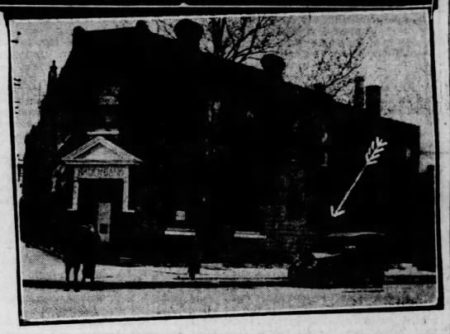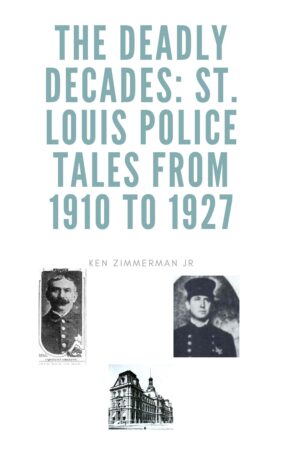Nas Rob Baden sij hawm thaum tsis muaj nyob rau hauv 1919
Ncig 10 yog txog hnub plaub, Tim 10, 1919, tsib hnyav ncawv armed txiv neej tawg lawm rau hauv txhab cia nyiaj Baden. Cov bandits confronted M.W. Muntzel, cov nyiaj ntsuab, thiab uas cog noob rau lub vault. Lawv npawv saum cov plaub lwm neeg ua hauj lwm ua Muntzel coj rau pawg rau lub vault.
Cov tub sab coj qhws dawb lias phuam los muab cais lawv nta. While two of the five men kept their revolvers trained on the employees, the three other robbers cleaned out the vault and the cashiers’ desks. The men completed the robbery in less than 4 feeb. After the police and bank authorities audited the bank, $40,000.00 thiab $45,000.00 was taken.

Photo from the April 10, 1919 St. Louis Post-Dispatch showing the position of the car outside bank (Public sau)
The robbers were going to shut the outer vault door, but Muntzel begged them not to close the outer door as all five employees would suffocate before anyone arrived to open the vault. The robbers left the outer vault door open but closed and locked the barred inner door.
The robbers’ act of humanity almost proved costly as they began to exit the bank. Muntzel knew a revolver was hidden in the vault. He grabbed it and began shooting at the robbers between the bars of the inner door. Txawm li cas los, the three shots did not hit any of the gang. Tsi, no customers were present at the time of the robbery.
While the five men were inside robbing the bank, three other gang members were lookouts on the outside. Two men were sitting in the running automobile, while one man waited by the front door of the bank to give an alarm and dissuade any customers from entering.
Muntzel’s gun shots attracted the attention of a St. Louis Patrolman, who ordered a mail truck driver to help him pursue the bandits. The Patrolman stood on the running board of the mail truck taking shots at the automobile with the eight bandits.
The robbers returned fire until they were able to elude the police officer on Geraldine Avenue. The rolling gun battle occurred over 4 mus 8 city blocks in North St. Louis. Tsi, no bystanders were struck by any of the bullets exchanged between the officer and the bandits.
With such a well-planned bank robbery, suspicion at once fell on professional bank robbers. Txawm li cas los, the crime was not solved at the time and the money was never recovered. Xyoo tom qab, it was revealed as the first bank robbery undertaken by Egan’s Rats. Max Greenberg was thought to have planned and conducted the robbery.
Egan’s Rats would be one of the few gangs who specialized in armed robbery during Prohibition. They did some bootlegging but were primarily involved in robberies and burglaries. Greenberg would have a falling out with the Rats and leave St. Louis for good in the early 1920s.
The automobile proved to be a powerful tool for criminals. Instead of being forced to run in their own neighborhood, criminal gangs could stretch outward and hit targets not in their traditional territory. It is a trend that continues today.
Koj yuav tawm ib saib los nug cov lus nug txog qhov no los yog tej tsev xa rau kuv Facebook phab.
Qhov chaw: St. Louis Dispatch tom qab, Tim 10, 1919, p. 1 thiab Egan tus nas: The Untold Story of the Gang That Ruled Prohibition-Era St. Louis by Daniel Waugh.
PIN rau nws

